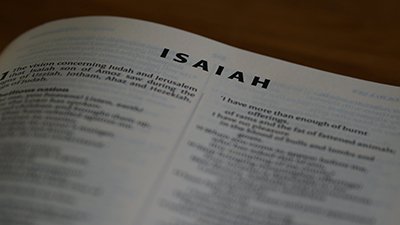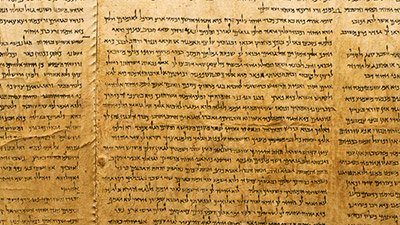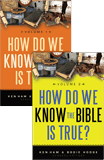
Examining the Newly Published “Sayings of Jesus” Papyrus
A newly published manuscript mixes Matthew, Luke, and the Gospel of Thomas. Should we be concerned?
Christians who speak and read English have the luxury of choosing between many good English translations of Scripture. Most don’t think too much about how the initial handwritten copies were transmitted through time and translated, eventually ending up as the leatherbound volumes we take to church.
However, most people don’t know much about ancient handwritten copies of Scripture or handwritten documents including Scripture and non-Scripture mixed together. So the media can portray a document that scholars would find interesting, but not transformative in how we view Scripture, as something that overturns our previous conceptions of Scripture.
Recently, a published ancient manuscript (P.Oxy. 5575) has been causing waves in the media because it contains text from the Gospels of Matthew and Luke mixed with text from the noncanonical Gospel of Thomas. As a New Testament specialist, I find this document interesting but not concerning in the least, and I hope to show you why in this article.
What Are the Oxyrhynchus Papyri?
In the ancient world, there were several options for how to write down information. If you wanted a fancy manuscript, you probably wanted a vellum scroll made of scraped animal skin. However, these were expensive. Most people couldn’t afford them, and most types of writing didn’t warrant such luxury. Otherwise, people wrote on everything from stone to clay, and even broken bits of pots. But one of the most popular and cheapest writing materials was papyrus. The fibers of the papyrus plant would be straightened out and woven together to create a paperlike page that was good for writing and cheap enough to be fairly disposable.
Oxyrhynchus was an Egyptian city that is famous today for preserving many papyrus manuscripts in its hot, dry climate.
Oxyrhynchus was an Egyptian city that is famous today for preserving many papyrus manuscripts in its hot, dry climate. They are buried in garbage dumps. Many of these papyri are biblical manuscripts, but many more aren’t. You are just as likely to find a tax receipt, a personal letter, or Greek poetry. In fact, only about 10% of the paper refuse in the Oxyrhynchus dumps contain literature,1 and the papyri that contain Scripture are a subset of those. Think about how many types of written refuse are in your local garbage dump: grocery receipts, sales flyers, torn up old books, badly written fan fiction. The difference is that your local climate is probably not conducive to preserving those papers for a couple thousand years!
What was trash around 2,000 years ago is today a treasure trove of information about that part of the ancient world. In the late 1800s–early 1900s, two papyrologists led a team who sifted through the garbage dumps to collect a vast amount of papyrus, many in pieces as small as a few square centimeters (less than a square inch). These are now stored and are being researched, but there is still much information that is yet to be published.
Thanks to Oxyrhynchus, we have tax receipts, personal letters, records of business transactions, and other fascinating glimpses into the ancient world. But what does it tell us about the Bible?
Jewish, Christian, and Heretical Texts in the Oxyrhynchus Papyri
In the several hundred years before and after the time of Jesus, there was a strong community of Jews in Egypt. Alexandrian Jews translated the Old Testament into Greek (this translation is known as the Septuagint and commonly abbreviated as LXX). The Oxyrhynchus dump bears witness to this with several LXX fragments, including a couple of vellum fragments, indicating that those particular documents were more expensive and may have been the property of a prosperous Jew or even part of a synagogue scroll. There is no particular way to tell a Jewish Old Testament fragment from a Christian Old Testament fragment, but the preservation of an Old Latin fragment of Genesis 5–6 indicates that at least some of them may have been Christian.
Out of 27 New Testament books, parts of 20 are represented in the Oxyrhynchus papyri. This gives us a good indication that the shape of the New Testament canon was similar to what we have today. We wouldn’t necessarily expect to find all the NT books, any more than we would expect to find all the OT books, because in the early years the NT books circulated and were translated as separate manuscripts (not as one volume as our Bibles today). This is a case where presence is significant, but absence isn’t necessarily as significant. We only have access to the papyri that have survived almost 2,000 years and have been unearthed, and not all of that has been published yet. There is no telling what has simply been lost to time or is sitting in storage in some university waiting for a researcher to notice it. However, the Oxyrhynchus papyri we have are a significant source of early New Testament writings, accounting for 40% of New Testament papyri.2
In addition, the Old Testament Pseudepigrapha3 are represented in the Oxyrhynchus papyri. These are documents mainly written in the time period between the Old and New Testaments and not considered Scripture by either Jews or Christians. There are also noncanonical Christian documents such as the Shepherd of Hermas and the Didache, and many pseudepigraphal works such as the Gospel of Thomas, Gospel of Peter, Gospel of Mary, and more.
Furthermore, we find documents like the Nicene Creed, Constantinopolitan Creed, writings from the church fathers Irenaeus and Theophilus 1 of Alexandria, and fragments of homilies and prayers.
In summary, the Oxyrhynchus papyri show that there was a thriving Jewish and Christian community in Oxyrhynchus, which is corroborated by other historical sources. And as we would expect in such a situation, we find a mix of Jewish and Christian documents, both canonical and noncanonical.
Why did all these texts end up in the trash dump? Some people want to argue that the biblical manuscripts from Oxyrhynchus aren’t of particular value, and as evidence, they point out that we essentially dug them out of the trash. But there are a number of reasons why a text could end up in the trash but still be valuable to us today. If someone had an old, worn-out manuscript of the Gospel of Matthew, for example, he may have commissioned a scribe to make a new copy, after which he disposed of the old copy. The old copy could still be an excellent-quality manuscript from a textual standpoint, and even if we only are able to retrieve a credit-card-size piece of it, we could still learn about what text types were present at that time in that city, which is important for Bible scholars to learn.
Apocryphal Gospels
As we examine this issue, it is helpful to note the background of the pseudepigraphal gospels. There are four canonical Gospels that we find in our New Testament: Matthew, Mark, Luke, and John. But there are many noncanonical and even heretical gospels. Some copy heavily from the canonical Gospels but make changes in certain areas to promote the author’s particular theological viewpoint. Some seek to fill in perceived gaps in the Gospels’ record of Jesus’ life—for instance, attempting to portray what Jesus’ childhood might have been like. Many pseudepigraphal gospels were written to advance a heresy called gnosticism, which fundamentally denied the goodness of the physical word and the physical human body, in particular, and had unorthodox views of Jesus Christ.
It should be noted, that contrary to what skeptics say today, the church leaders did not decide which books should be considered inspired Scripture based on ecclesiastical preference or theological power, but they listed the books that already had been recognized by Christians as being inspired. In other words, the canon lists did not determine what Scripture was, the canon lists were simply the church’s recognition of the books that God inspired.
Sayings of Jesus Papyrus
With this background, finally we can examine the newly published papyrus. This document is made up of two fragments that scholars have identified as part of the same manuscript. It has been dated by conservative and mainstream scholars as coming from the AD 200s or early 300s. This makes it a very early fragment in relative terms to most extant biblical manuscripts. The document contains parts of Matthew 6, Luke 12, and Thomas 27 (Gospel of Thomas quote is in italics):5
. . . he died.6
“I tell you, do not worry about your life, what you will eat, or about your body, what you will wear,”
“If you do not fast from the world, you will not find the kingdom. If you do not make the Sabbath a sabbath, you will not see the Father,”
“Look at the birds of the air; they neither sow not reap nor gather into barns, and yet your heavenly Father feeds them. Are you not of more value than they?” “Consider the lilies of the field, how they grow; they neither toil nor spin, yet I tell you, even Solomon in all his glory was not clothed like one of these. But if God so clothes the grass of the field, which is alive today and tomorrow is thrown into the oven, will he not much more clothe you—you of little faith? Therefore . . . and indeed your heavenly Father knows that you need all these things. But strive first for the kingdom of God and his righteousness, and all these things will be given to you as well.”
Whatever this document was, it’s pretty clear it wasn’t attempting to be an entire Gospel. Rather, it’s a collection of thematic sayings of Jesus (or in the case of Thomas, claimed sayings of Jesus) regarding trust in God and not worrying about accumulating worldly goods. While Thomas is a gnostic Gospel, the quotations included here are not overtly gnostic. In fact, it might be uses like these that occasioned the canon lists to clarify which books contain trustworthy and accurate records of Jesus’ life and teaching.
This is both the earliest attestation of the Gospel of Thomas and the earliest text from Matthew 6 we currently have, so it is of interest for that reason. It confirms that our more complete copies of the Gospels, which date from a century or two later than this document, were copied accurately and represent what was originally written by inspiration of the Holy Spirit.
We know from church history and the writings of the church fathers that the gnostic family of heresies was popular, starting with protognosticism even in the apostles’ day. The presence of gnostic fragments in Oxyrhynchus tells us that this heresy was active there. We can only hope this particular fragment ended up in the trash heap because its owner realized it was defective!
We Can Trust the Bible!
This find and the discussion it has sparked is important because not only can we trust that God inspired Scripture as an authoritative and inerrant set of books, but we can trust that we have those books today because they have been preserved. The New Testament documents, in particular, are the best-attested works of antiquity.
It’s important for us to know where the Bible came from so that we can put finds like this in their proper context.
It’s important for us to know where the Bible came from so that we can put finds like this in their proper context. We can even praise God for the discovery and publication of texts like this because they are another piece of evidence for the accuracy of the copying process that ultimately gave rise to the text our Bibles today are translated from.
Footnotes
- Wikipedia, “Oxyrhynchus Papyri,” last modified September 19, 2023, https://en.wikipedia.org/wiki/Oxyrhynchus_Papyri.
- Michael J. Kruger, “New ‘Gospel’ Manuscript Discovered? (What It Is and Why It Matters.)” The Gospel Coalition, September 23, 2023, https://www.thegospelcoalition.org/article/new-gospel-manuscript-oxyrhynchus/.
- This word is from the Greek meaning “false writing.” It refers to writings that are falsely attributed to a trusted author, such as a recognized apostle or prophet of God.
- A canon list attempts to give a list of authoritative books, sometimes explicitly excluding noncanonical books. You can view the major ancient canon lists at https://www.bible-researcher.com/canon8.html.
- Reconstructed English translation of text from https://www.nasscal.com/e-clavis-christian-apocrypha/papyrus-oxyrhynchus-5575/.
- Hypothesized to be the ending of Thomas 63: Jesus said, “There was a rich man who had much money. He said, ‘I shall put my money to use so that I may sow, reap, plant, and fill my storehouse with produce, with the result that I shall lack nothing.’ Such were his intentions, but that same night he died” (https://www.marquette.edu/maqom/Gospel%20of%20Thomas%20Lambdin.pdf).
Recommended Resources

Answers in Genesis is an apologetics ministry, dedicated to helping Christians defend their faith and proclaim the good news of Jesus Christ.
- Customer Service 800.778.3390
- © 2024 Answers in Genesis





